Myths travel faster than water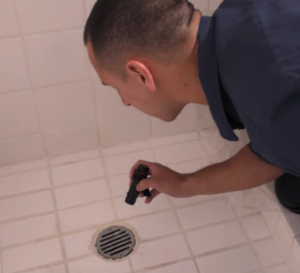 In Tampa, everyone’s got a clog story—and a “can’t-miss” fix. Some work. Many don’t. After two decades of clearing drains from Palma Ceia to New Tampa, Cass Plumbing has the receipts. Here’s what’s true, what’s marketing, and what actually clears a line for good.
In Tampa, everyone’s got a clog story—and a “can’t-miss” fix. Some work. Many don’t. After two decades of clearing drains from Palma Ceia to New Tampa, Cass Plumbing has the receipts. Here’s what’s true, what’s marketing, and what actually clears a line for good.
What trips up Tampa drains isn’t one thing—it’s our climate and our mix of old and new infrastructure. Summer downpours push silt and organics into yard drains. Older cast-iron laterals in historic neighborhoods build up scale. Live-oak roots find hairline joints; busy kitchens feed grease into lines that were never meant to be deep-fried. Add in low spots (“bellies”) from settling soil and you’ve got slow drains that turn into full backups at the worst possible time.
Cass Plumbing’s approach is simple and proven: diagnose first, choose the right clearing method, then fix the root cause. That means camera inspections instead of guesswork, jetting when grease and scale demand it, and trenchless or spot repairs when the pipe itself is the problem. No gimmicks. No one-size-fits-all “miracle” in a bottle. Just Tampa-tested solutions that keep water moving the way it should—out and away.
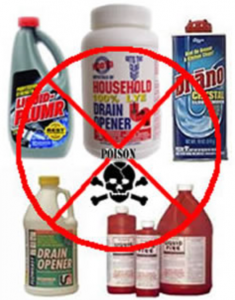 Myth #1: “Chemical drain cleaners are the quickest, cheapest fix.”
Myth #1: “Chemical drain cleaners are the quickest, cheapest fix.”
Reality: They can damage older pipes, especially cast iron, PVC glue joints, and rubber gaskets. They also fail on grease, roots, and heavy scale. The smart first step is a mechanical clear (cable or jet) followed by a camera inspection so you know why it clogged.
Here’s the bigger problem: chemical drain cleaners don’t just sit politely in the pipe. Many generate intense heat during reaction, which can warp PVC, accelerate corrosion in cast iron, and soften rubber seals. If they don’t fully dissolve the blockage, the chemical slurry can pool in a low spot (“belly”) and keep cooking your pipe from the inside. Worse, if someone later tries to cable the line, that pooled chemical can splash back—hazardous for skin, eyes, and lungs.
They’re also easy to misuse. People often double-dose or mix products (or combine with bleach, ammonia, or enzyme cleaners), which can release toxic fumes or trigger violent reactions. Even when “successful,” a chemical quick-fix masks structural issues—roots, offset joints, collapsed sections—that only show up on camera. Translation: the clog returns, the pipe is weaker, and the next failure is usually bigger and messier.
Horror story (Tampa true-to-life): A South Tampa homeowner poured two different “industrial-strength” cleaners into a slow kitchen line over a long weekend. The clog didn’t move, but the heat did—softened a PVC elbow behind the cabinet and ate through the rubber coupling on the branch. By Monday morning, the line finally let go. Caustic water leaked under the base cabinets, blistered the finish, warped the hardwoods, and seeped into the crawlspace. When they called for help, the line was still filled with active chemical—too dangerous to snake immediately. We had to neutralize and wet-vac the run, ventilate, and gear up with full PPE just to make it safe to work. What should’ve been a simple cable-and-jet became a kitchen rebuild plus a partial pipe replacement—several thousand dollars more than a proper mechanical clear and camera inspection would have cost on day one.
Safer path: Skip the chemistry set. If a drain is slow, stop running water, avoid mixing any products, and don’t attempt to snake a line that might contain chemicals. Call a pro to mechanically clear the blockage, jet when needed, and camera the line to verify the cause—roots, grease, scale, or a structural defect—and fix it for good. Cass Plumbing will also set you up with a preventive plan (enzyme maintenance for organics, periodic jetting for heavy-use lines) so you don’t end up rolling the dice on your plumbing—or your cabinets—again.
Myth #2: “Red clay is the main reason my drains back up.”
 Reality: Tampa’s backups are more often grease, scale, bellies (low spots), and roots entering through joints or cracks. Clay soils matter because they shift and hold moisture, stressing older laterals—but the fix isn’t a bottle, it’s a targeted repair (spot repair, lining, or full replacement) after a proper camera survey.
Reality: Tampa’s backups are more often grease, scale, bellies (low spots), and roots entering through joints or cracks. Clay soils matter because they shift and hold moisture, stressing older laterals—but the fix isn’t a bottle, it’s a targeted repair (spot repair, lining, or full replacement) after a proper camera survey.
Enhancement:
Red clay is part of the story, not the villain. What clay really does is amplify existing weaknesses. When saturated during summer storms, clay swells and settles unevenly, which can turn a tiny offset into a belly that traps grease and solids. That belly becomes a permanent “catch basin,” so every rinse loads more debris until the line crawls. Without a camera, you’ll never know you’re feeding a problem you can’t see.
The Tampa fix starts with diagnostics—a camera inspection that tells you whether you’re dealing with scale in old cast iron, root intrusion at a joint, or a sag in the line. From there, we choose the right remedy: precision jetting to restore flow, spot repairs for cracks, or trenchless lining to seal joints and stop roots. Address the defect and the “clay excuse” stops mattering.
Myth #3: “Hydro jetting is overkill.”
 Reality: For heavy grease, scale, and root fuzz, jetting is the gold standard. Cass Plumbing uses the right nozzles for the job: rotary nozzles for scale, penetrators for sludge, and flushers to carry debris to the main—then follows with a camera to verify a clean, round pipe.
Reality: For heavy grease, scale, and root fuzz, jetting is the gold standard. Cass Plumbing uses the right nozzles for the job: rotary nozzles for scale, penetrators for sludge, and flushers to carry debris to the main—then follows with a camera to verify a clean, round pipe.
Enhancement:
Cabling is great for poking a hole through a blockage; jetting is about restoring pipe diameter. In Tampa kitchens (think frying, smoked meats, and seafood), grease cools on pipe walls and hardens into a waxy ring that a cable may only tunnel through. Jetting attacks the entire circumference, shaving off scale and emulsifying fat so it actually leaves the system instead of re-settling a few feet downstream.
“Overkill” is paying twice for the same problem. Proper jetting, paired with a post-clean video verification, often extends the time between service calls dramatically. For commercial lines or busy households, we’ll set a preventive jetting schedule (quarterly/biannual) so you avoid emergency rates, weekend messes, and surprise closures.
Myth #4: “Enzymes will fix everything if I just keep pouring.”
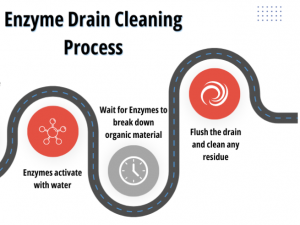 Reality: Enzymes help maintain healthy lines by digesting organic matter, but they won’t remove a hard blockage or fix a structural defect. Think of enzymes as a toothbrush, not a root canal. We often put customers on a maintenance plan after a professional clean.
Reality: Enzymes help maintain healthy lines by digesting organic matter, but they won’t remove a hard blockage or fix a structural defect. Think of enzymes as a toothbrush, not a root canal. We often put customers on a maintenance plan after a professional clean.
Enhancement:
Enzymes are excellent aftercare. Once a line is mechanically cleared and jetted, dosing enzymes helps keep soft organics in check and supports a healthier biofilm. But enzymes can’t chew through mineral scale, foreign objects, or correct a sunken section of pipe. If your line re-clogs quickly after enzyme use, it’s waving a flag for a structural issue that needs eyes-on-camera.
The winning formula is: clear → inspect → fix → maintain. We start with a mechanical clear, run a camera to identify defects, recommend repairs if needed, and then use enzymes as a maintenance tool—especially for kitchen laterals and long, low-slope runs. That’s how you turn a chronic clog line into a predictable, low-cost maintenance line.
Myth #5: “If water drains eventually, the pipe is fine.”
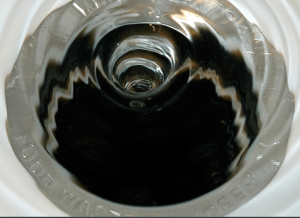 Reality: Slow drains suggest partial blockage or improper slope. Over time, that becomes a full backup—usually at the worst possible moment. A camera inspection can save a weekend of chaos.
Reality: Slow drains suggest partial blockage or improper slope. Over time, that becomes a full backup—usually at the worst possible moment. A camera inspection can save a weekend of chaos.
Enhancement:
“Eventually” is the most expensive word in plumbing. Slow drains indicate reduced capacity—from grease rings, scale blooms, or a forming belly. As capacity shrinks, any surge (laundry day, holiday cooking, big showers) overwhelms the line, and everything backs up at once. The pipe didn’t fail that day—it warned you for weeks.
A short camera inspection answers the two questions that matter: What caused the slowdown, and where? If it’s soft debris, we jet. If it’s a defect, we repair (spot, liner, or replacement). Either way, you get video proof and a clear path to prevent the next emergency—before guests arrive, before the floors warp, and before you’re Googling “emergency plumber Tampa” at midnight.
The Tampa truth: what actually works
-
Start with diagnostics: We camera the line so you see what we see.
-
Choose the right clearing method: Cable for soft obstructions; hydro jet for grease/scale; root cutting heads when roots are present.
-
Fix the root cause: Spot repair, trenchless lining, or full replacement where needed.
-
Maintain smart: Scheduled enzyme dosing and annual checks for known trouble lines.
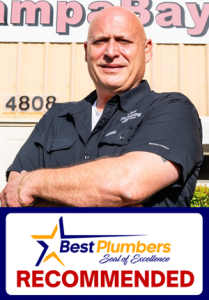 Cass Plumbing’s local edge
Cass Plumbing’s local edge
-
Local & family-owned with A+ BBB rating and 1,000+ 5-star reviews
-
Recommended by Best Plumbers (the #1 plumbing directory)
-
Full toolkit: jetters, cutters, cameras, locators, trenchless solutions
-
Transparent options: photos/video, clear pricing, and honest recommendations
If a drain in Tampa is talking back—don’t guess. Book a drain diagnostic + clear with Cass Plumbing and get video proof your line is right.
FAQs
Q: How do I know if I need jetting or just cabling?
A: If grease/scale are present—or the line reclogs quickly—jetting typically delivers longer-lasting results. We verify with camera video.
Q: Will trenchless lining work on my old lateral?
A: Often, yes. It depends on the existing pipe’s condition and diameter. We camera/locate first and show you options.
Q: Are enzyme treatments safe for septic?
A: Quality enzyme products are generally septic-safe. We’ll recommend the right product and schedule for your system.






